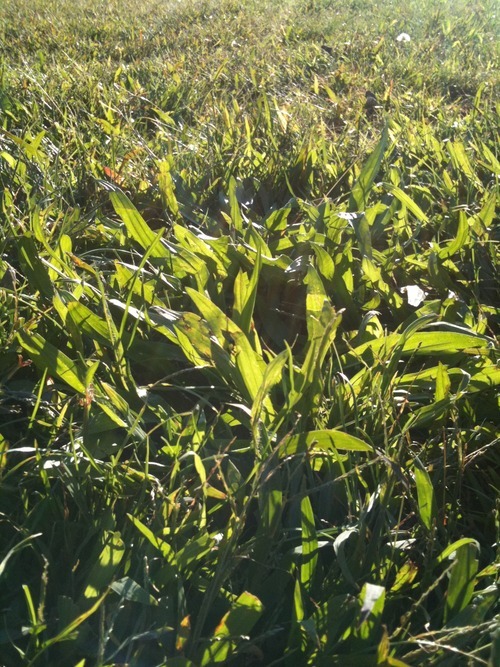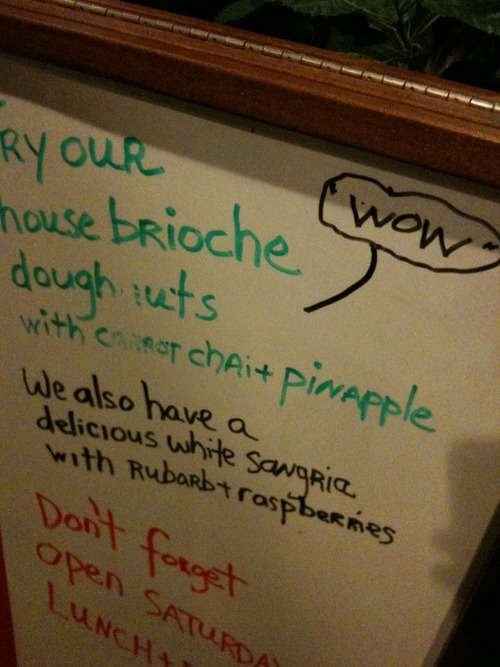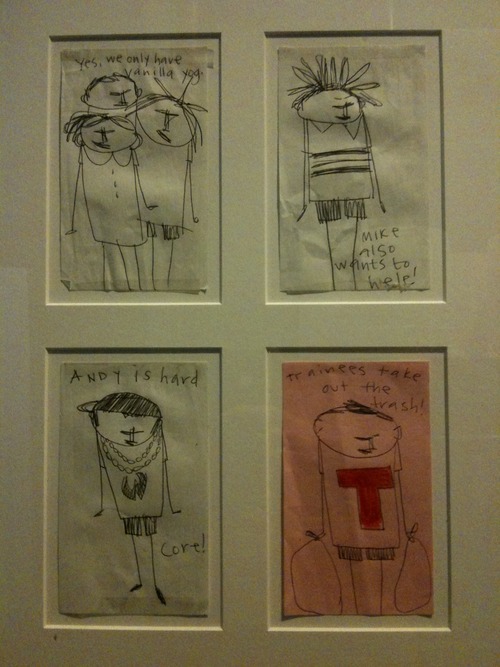By the next day at lunch, Kant and Wittgenstein had dissolved in the marinara on the fifty-cent spaghetti plate at Romeo's. I returned to Rimbaud, Apollinaire, and Char for wisdom, abandoning forever the academic pursuit of trying to answer questions that no one ever asks.more jim harrison here.
jim harrison, "principles" in the raw and the cooked
Sep 28, 2011
solution
Posted by
vaughn tan
0
comments
![]()
![]()
Labels: books, execution failure, execution success, food, intransigence, intuition, theory
duck duck goose
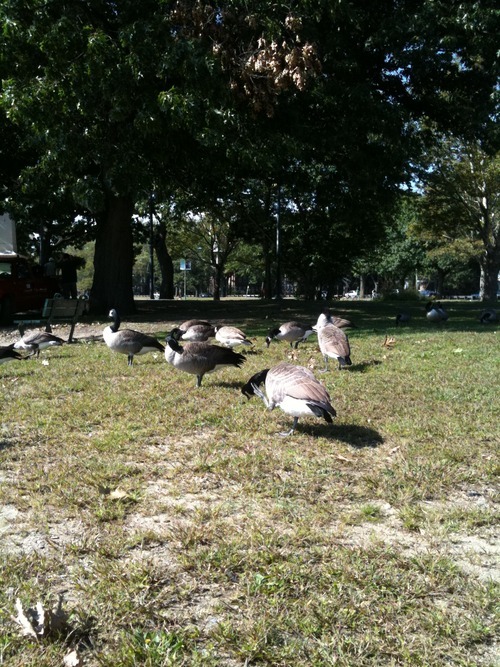
the only advantage of reading on a barren patch by the river is that it is relatively free of goose shit.
Posted by
vaughn tan
0
comments
![]()
![]()
Labels: cambridge
Sep 22, 2011
this just in
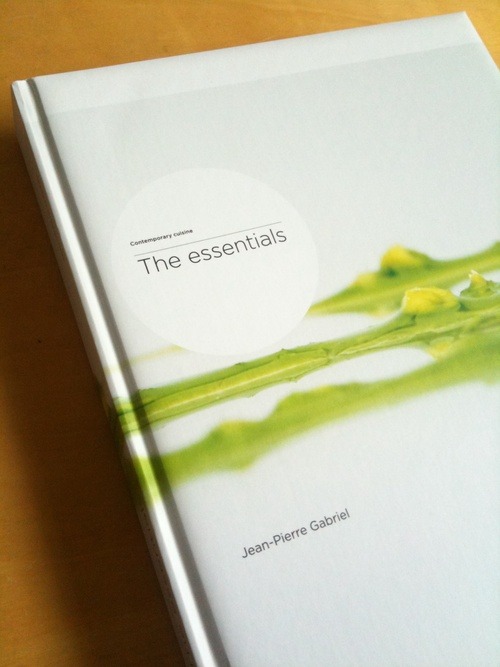
a battered box from belgium arrives, its contents fortunately unscathed. the essentials (unilever, 2009) is lavishly illustrated and filled with commentary and recipes from a slew of dutch chefs. at first glance it appears to be a precursor to modernist cuisine. more later, after a much longer look.
[thx, j-pg]
Posted by
vaughn tan
0
comments
![]()
![]()
how chefs can (help) save the world
Though lacking a grand theme, a common thread ran through Planting Thoughts, a food symposium held in Copenhagen in late August that promised serious thinking and discussion about food. Good food, the diverse crowd of speakers (chefs, food scientists, farmers, biologists, foragers, and more) argued, takes time and effort from everyone involved in making it: There are no short-cuts. The symposium also showed how haute cuisine—often derided as elitist—can support efforts towards building a system that can make enough good, sustainably grown food for everyone and make it accessible to all.
Most obviously, haute cuisine can extend and reinvigorate local food culture and history, the context of people, places, stories, and traditions that surrounds food in a given place. Fine dining restaurants can afford to pay a premium for what we now think of as artisanal ingredients, keeping them in production and their producers in business. Less obviously but more importantly, many chefs use culture and history when creating new dishes in their restaurants. Japan's Yoshihiro Narisawa, Italy's Massimo Bottura, Spain's Andoni Aduriz, Australia's Ben Shewry, Daniel Patterson from the United States—they all use the historical and cultural context in which they work to help them answer the question: "This was what came before, what should we cook next?"
Patterson's food is an example of how culture and history can point chefs in the right direction. He often researches how particular ingredients have historically been cooked, then bases novel interpretations on what he finds. At the symposium, he showed three beet dishes in which he took the familiar texture of the roasted beet (from the roasted beet and goat cheese salad that was introduced in the late 1970s and is now ubiquitous) and transformed it into something new but—crucially—not forbidding. Here's one: roasted beets on a rose-scented snow with yogurt, a novel pairing of flowers and earth, united by the familiar combinations of floral/milky and earthy/milky flavors. Chefs like Patterson create new and delicious things by returning to what we already know. For them good food is anchored in context, and requires investigation of place, time, and history.
Clearly, the labor-intensive food these chefs make will never be the food of the people. This is why haute cuisine seldom participates in discussions about how to feed many people sustainably and healthfully. This is a false divide. Even if the food itself does not scale up from the fine dining restaurant, the approach—examining context more closely—could be part of the solution.
Looking to history and culture helps us understand why we eat the way we do today. Thousand of years of food choices have led us to eat mostly starches from a few cultivated plants instead of the diverse set of foods that we used to eat. This modern, developed-country way of growing food and eating has expanded dramatically in the last half-century. Accelerating urbanization and changing work patterns during this time have made it less likely that families cook and eat together. Now, it's the exception rather than the rule to eat good food made with care, that originates in a place and with people that you know, part of a culture and history that you share. "You would think that at the end of thousands of years of development, it would take a long time to destroy these memories of good food," Patterson said, "but industrial agriculture took that all away in a generation, wiped it all out."
Our food production and distribution system is a litany of connected problems. We grow more food per capita than we need, but we grow the wrong food, in the wrong places, in the wrong way. On average, we consume more calories than we require. Industrial agriculture produces trillions of calories but at tremendous and mostly hidden cost. The energy spent in manufacturing the fertilizers and pesticides, operating the machinery, and fueling the transport required for industrial agriculture is hidden in subsidies on agriculture, fuel, and transportation. Our starchy diet is associated with chronic health problems that we pay for indirectly with taxes and overloaded health-care systems. When cheap energy finally becomes too expensive and the chronic health crisis can no longer be ignored, what we choose to eat and how we we grow, process, transport, prepare, and sell it will have to change.
What, then, might the future of food look like? About the only certainty is that it will have to be built from a lot of smaller solutions rather than a single industrial mega-solution. Hans Herren, an author of the IAASTD (an international review of agricultural knowledge), noted that small-scale organic farming is as productive as the world average for agricultural production, and challenges the widely held assumption that mechanized, industrial agriculture is the only viable solution. While too many people live in urban areas for all agriculture to be local, Thomas Harttung, an urban agriculture advocate, suggested that urban agriculture can produce an enormous volume of food to supplement our food supply. The foragers who spoke at Planting Thoughts, Miles Irving and Francois Couplan, also argued that wild foods are diverse and plentiful enough to be as meaningful and delicious a part of our food supply in the future as they were in the past. Diversifying our food production systems is critical, and this means including elements based on old ways of doing things like foraging and local, organic production methods, but with the advantage of new knowledge.
Changing how we produce, distribute, and consume food will require us to unlearn what we take for granted now: apparently cheap food, reliance on starches, unnecessarily abundant calories, eating a lot of meat. Then we'll have to learn something new: spending time and effort to find and make real food, growing and eating closer to home, eating less but better, eating more plants. This will be tremendously difficult. A change in our food system won't happen if it isn't supported by an equally radical change in our food culture.
Change, though, is easier if it is delicious and pleasurable—and this is where haute cuisine comes back into the picture. Chefs are, as Michel Bras called them, "marchands de bonheur," their know-how employed in making delicious things. This knowledge gives chefs the ability to use pleasure to help change what people want to eat. "Poor choices lead to unsustainable foods," Ben Shewry said. "The responsibility of the chef is to know and to act." Activists for sustainable food and food access rightly emphasize how urgently we need to change our food system. Chefs can help make that change delicious and desirable, not just necessary and inevitable.
click here for other posts about Planting Thoughts, including session summaries.
[this post was cross-published in The Atlantic|Life]
Posted by
vaughn tan
0
comments
![]()
![]()
Labels: biology, complexity, copenhagen, decisions, execution success, food, government, history, instruction, planting thoughts, sustainability, technology, theory
Sep 20, 2011
reason
So convenient a thing it is to be a reasonable Creature, since it enables one to find or make a Reason for everything one has a mind to do.
Posted by
vaughn tan
0
comments
![]()
![]()
Labels: intransigence
Sep 19, 2011
the hard truths
jd: let's go to this
vt: i won't fit in. i don't have a massive beard.
jd: see below.

Posted by
vaughn tan
0
comments
![]()
![]()
Sep 18, 2011
sofra
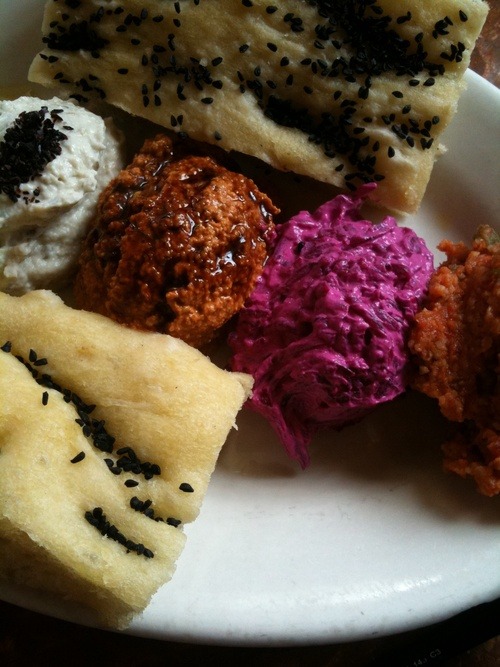
L-R: baba ghanouj, muhammara, beet tzatziki, tomato kibbeh
Posted by
vaughn tan
0
comments
![]()
![]()
Labels: cambridge, execution success, food
Sep 15, 2011
Sep 12, 2011
planting thoughts: session 4, sunday p.m., 8/28
michel bras (chef at bras, laguiole)
vivre la cuisine
for michel bras, quality is a whole activity: it encompasses the cuisine, the ingredients and how they are grown, the architecture of the restaurant, how the staff are treated. the iconic gargouillou of individually cooked young vegetables is "a state of mind" emblematic of bras's approach to cooking. it changes with the vegetables, plants, and flowers that are available, and is his way of communicating through a dish the feeling of being in nature and of being aware of the season. bras calls the gargouillou "a way of looking at nature," an expression of the decades-long relationships he has with the farmers in his part of france, a statement of his belief that it's valuable to sometimes concentrate on what is perfectly ready in the moment. chefs are "marchands de bonheur," their task to produce emotion, delight, and joy in the diner, regardless of the type of food they make. a correctly prepared gargouillou is laborious but transmits a sense of joy in time and place to the diner. food can have the same effect even if less elevated: a tartine of bread selected with care for the right proportion of crust to crumb, just enough shaved chocolate, a few red berries, and a milk skin--simple, delicious pleasure.
harold mcgee (author)
the flavours of plant life
"plants," harold mcgee says, "are the chemical masters of the universe." the chemicals they produce from rocks, air, sunlight, and water make them taste different and, in some cases, delicious. these chemicals serve different purposes. the flavours and aromas of fruit are designed to attract and please animals; in a sense they are complex pre-cooked foods made by plants to be eaten. the flavours we associate with herbs and spices, on the other hand, are often chemical weapons plants produce in response to their environment. understanding the logic of this plant biology and chemistry helps chefs cook better. for instance, the undesirable green and grassy aromas in herbs are produced when the leaves are damaged and the chlorophyll in them breaks down. knowing that the desirable aromas are from oils in hairs on the leaves, slapping the leaves rather than cutting or crushing them produces an aroma with more desirable than undesirable notes. knowing that flavours are essentially a plant's response to the environment may also support the quality claim that organic agriculture makes. use of pesticides and herbicides reduces the stress crop plants experience and, if flavour and aroma compounds are plant responses to stressful environments, possibly makes them less flavourful as a result.
david chang (chef at the momofuku restaurants, new york)
food microbiology: an overlooked frontier
david chang claims that he didn't do well in school--"cooks are allergic to learning and scientific terminology"--but regrets it now. the most exciting projects at momofuku now center on learning how to use microbes to produce more delicious food. one misconception about food is that bacteria and fungi are bad. other than the yeasts and bacteria that make bread, beer, and wine, we think of other microbes as pathogens. yet, microbes can transform raw ingredients in an almost infinite number of ways. microbial growth on food is so affected by local climate and microbe populations that we should think of the flavours of microbial activity almost as another form of terroir. chang and dan felder, who runs the momofuku test kitchen, illustrated this with what they call pork bushi (inspired by katsuobushi, the inoculated, dried bonito that is ubiquitous in japanese cooking). they prepared pork the same way fresh bonito would be prepared for katsuobushi and were surprised when the usual aspergillus molds didn't take hold on the pork. instead, in the new york city air, yeasts from the pichia family flourished on the pork and produced savoury flavours similar to katsuobushi. but they weren't able to get consistent results until some professional microbiologists helped them refine their pork bushi production protocols. chang's goal as a chef is to keep learning more and, these days, learning more often requires chefs to move out of their comfort zone and challenge themselves by returning to the scientific method.
andoni aduriz (chef at mugaritz, guipuzcoa)
natural and cultural ecosystems
at mugaritz, andoni aduriz says, they try to work with what they have, to take the time to respond rather than try to control. taking time and care produces a special product worth waiting for. mugaritz is connected to the place in which it exists by relationships with suppliers, local history, and local culture. for example, the idiazabal cheese that they buy is endangered, the latxa and carranzana sheep from which milk idiazabal is historically made are wild-pastured and less productive than barn-raised sheep--mugaritz's commitment to buying and producing locally is, to aduriz, a critical form of historical and cultural support that keeps communities and traditional ways of doing things alive. what they buy is not only the flavour of these foods, but the time and care expended, the history and culture embodied in them. "our food is very simple," aduriz said, "we like to eat stories."
gaston acurio (chef at astrid y gaston, lima)
the power of food
food has the power to change things--gaston acurio has seen it happen in peru. the new peruvian cuisine began with chefs rediscovering peru's enormous biodiversity. peruvian chefs learned to stop hankering for products from other parts of the world: "using our biodiversity on our own plates felt like a scream of freedom." but after they'd found local ingredients that tasted good, they began to be concerned with justice for food producers, with food access for the poor, and with health. they realised that peruvian cuisine becomes sustainable only if all these pieces are in place--when client, chef, and producer alike are happy. they developed free schools where chefs taught people to cook to change their livelihoods, worked with producers to fight big businesses that were polluting the rivers and fields where food was grown. "all this is accomplished by the power in our hands," acurio said, "there is no limit to what food can change."
other posts about planting thoughts:
planting thoughts: a symposium without dissenting views,
summaries: session 1, session 2, session 3
Posted by
vaughn tan
0
comments
![]()
![]()
Labels: care, complexity, decisions, epistemology, execution success, food, intuition, moral fibre, planting thoughts, sustainability, technology
our denver correspondent

ben sends a photograph of a sandback installation at mca denver; show looks good. for more sandback, also see here and here. might want to check out ben's work too.
Posted by
vaughn tan
1 comments
![]()
![]()
Labels: art
planting thoughts: session 3, sunday a.m., 8/28
stefano mancuso (director, international laboratory for plant neurobiology)
the unexpected plant: beyond the animal model
we should re-examine our preconceptions about plants as unthinking, unmoving things. stefano mancuso explained how plants are able to sense and respond to changes in their environment with more precision and sophistication than we expect. some plants (like sunflowers) appear to learn how to respond to the environment collectively, so that they may be thought to be social organisms. plants have also evolved together with the animals that live around them (including humans). they make use of animals to reproduce and protect themselves, using tasty fruit to induce animals to transport their seeds or protect them from other animals. we might, for instance, think of domesticated plants such as wheat or corn as having trained humans to protect and propagate them with enormous success. plants have also developed remarkable systems for protecting them from threats in their environment: the chemicals plants produce repel insects, warn nearby plants of imminent attacks insects, and also happen to sometimes taste good to humans.
alex atala (chef at DOM, são paulo)
insects and plants: together for life
eating insects seems unfamiliar and scary, alex atala said, but everyone who has ever eaten strawberry yogurt has eaten insects in the form of a red dye which is extracted from cochineal beetles. we seek the familiar because our experiences only make sense in terms of what we have experienced before. he distributed cubes of unflavoured agar, each containing a piece of the amazon: a single amazonian ant. many people in the audience thought it tasted of lemongrass and citrus but atala pointed out that to people who have grown up eating those ants, lemongrass and citrus taste like ants. atala's point was that we should not take for granted culturally defined rules of what should and should not be eaten. "to understand a flavour better," he said, "we must take ourselves away from the familiar." after cooking for years in european restaurants, he realized he had to go back to brazil to explore the then-unknown flavours of his country, rather than trying to cook the food of a different part of the world. his restaurant in brazil now uses the amazon as a source for new and unfamiliar ideas and ingredients that even most native brazilians have never had the opportunity to taste--raw propolis-filled rainforest honeys, spontaneously fermented sugarcane vinegars, a panoply of forest herbs and plants, and others. the enormity and diversity of the country-spanning amazon paralyzes what atala calls "the sophisticated world": in dogshead, one relatively small part of the amazon, there are 23 ethnicities, 21 languages, and over 300 varieties of domesticated plants that are not known outside that region. the amazon as a whole is "a world of flavours remaining to be discovered." atala's understanding of the region's foods comes from natives whose knowledge is anything but simple. atala increasingly believes that our efforts to preserve nature must also include plans to preserve peoples and cultures, or rich stores of local knowledge and practices will be lost.
francois couplan (ethnobotanist, author)
wild plants and culinary creativity
80,000 wild plants are known to be edible and were once eaten--a balanced, diverse, interesting, healthful diet. we've forgotten about most of these wild plants because of the rise of agriculture, and because eating wild plants used to signal low social status. couplan believes that there is a fracture of the wild and the civilised that is leading us to unbalanced, monotonous diets that depend too much on cultivated plants and which make us sick. our diets will improve if we are able to be opportunistic in combining both farmed foods and foraged foods, gathering what we can, when we can. this can only happen if more people learn about how edible wild plants can be used. this, couplan believes, is where haute cuisine comes into the picture. he has taught chefs in france and the rest of europe how to identify, gather, and use wild plants in their restaurants. "when chefs start using plants," he said, "they become stars and are not anymore despised. people begin to want to learn about them."
massimo bottura (chef at osteria francescana, modena)
never stop planting
trapped in new york by hurricane irene, bottura sent a video (subtitled version available on eater) and a statement instead. bottura believes that food should be an object of contemplation, not just one of consumption. we've turned into lazy eaters, pursuing pretty, superficially satisfying foods that are sweet, smooth, and unctuous. challenging food changes those who eat it, bottura thinks, and chefs should be helping people learn to eat challenging food again. to do this, chefs have to acknowledge that food is not only about aesthetics but also about ethics. cooking ethically means going back to the source of ingredients and influences, and acknowledging the culture and history from which the food comes. without these creation stories--stories from friends, suppliers, customers, neighbours--food loses its connection to place, time, and people. without being aware of this connection and reflecting it in, the chef's job is incomplete. "food is one of the strands of the cultural braid that binds us," bottura said "our business is not only about serving people food. that is only the final act."
søren wiuff (farmer)
all that we eat has been alive
søren wiuff changed how he farmed years ago when he realised that he couldn't make money farming industrially even though his farm was highly productive. he went back to doing things as his father did: by hand and with care, "learning what will grow in the garden, feeling your body as part of harvesting something." his close connection with the crops he grows led him to question many of the assumptions farmers usually have about what they grow and how they grow them. he gradually learned how to respond to the unpredictable, changing nature of the living things on his farm rather than trying to force them to fit into a recipe, a formula, a set of preconceptions. this has led to his accidental discovery of new crops: sowing leeks later in the season than usual (so late that wiuff thought the cold would kill them) led him discover baby leeks that sprout in april of the following year, or tasting the usually discarded aerial bulbils of mature leek plants. he credits this partly to support from working with chefs--like those at noma--who are open to trying these new and unfamiliar ingredients and making delicious things out of them. "it's like having playmates," he said, "they make me good by respecting that i'm a farmer. if someone tells me i'm doing something good, i do better next time."
molly jahn (univ. of wisconsin and commission on sustainable agriculture and climate change)
how good food can save our planet
people have to demand healthy food systems for them to take hold and become successful. when molly jahn was working as a plant breeder, she collaborated with organic farmers to develop a new variety of delicata squash that was delicious and more pest-resistant. she targeted organic farmers and chefs in her her efforts to promote the variety, and realised that the variety became successful when chefs demanded it, put it on their menus, and exposed it to consumers. much later in her career, when she had begun to work on agricultural policy in wisconsin, she helped a group of potato farmers in the state develop a stringent integrated pest management and certification program (eco-grown) to protect wildlife on and around their farms. though the program was successful in its environmental goals, she thinks that it never achieved commercial success because chefs were not as involved in its promotion. jahn's message to chefs was simple: "chefs help accelerate people's valuation of good, responsibly produced food."
other posts about planting thoughts:
planting thoughts: a symposium without dissenting views,
summaries: session 1, session 2, session 4
Posted by
vaughn tan
0
comments
![]()
![]()
Labels: agriculture, complexity, copenhagen, decisions, education, food, government, planting thoughts, research, sustainability, technology
Sep 11, 2011
chicken and waffles
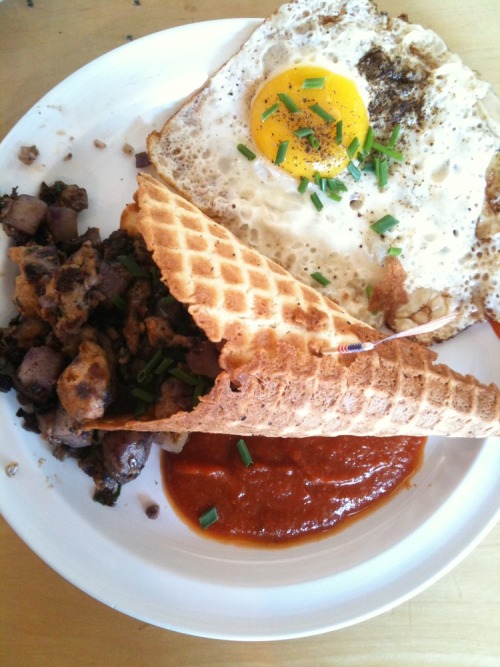
chicken sausage, red carrot, and potato hash, fried egg and chives, waffle cone, chili ketchup, american flag. at toscanini's, where breakfast now comes only one weekend a month.
Posted by
vaughn tan
0
comments
![]()
![]()
Labels: cambridge, execution success, food
Sep 10, 2011
planting thoughts: session 2, saturday p.m., 8/27
kamal mouzawak (founder, souk el-tayeb)
make food not war
"difference," kamal mouzawak believes, "can be a reason for war or a celebration of diversity." his producer-only farmers' markets in lebanon attempt the latter by bringing people and producers from rural and urban areas together. direct contact between producer and consumer is important: it gives recognition to the producer, teaches the consumer about food and who it comes from, and builds trust in the food system. "food is not a commodity," he noted, "it is not something you just buy. it is something people grow, buy, and cook." his markets are designed to not just be places where people can buy and sell products but also places where traditions and stories can be exchanged and kept alive.
inaki aizpitarte (chef at le chateaubriand and le dauphin, paris)
rené mosse (winemaker, domaine mosse)
coquina et naturali vinorum
culinary inspiration can come from anywhere. for inaki aizpitarte, inspiration comes from wine, particularly natural wines that are different, that are not homogeneous. these wines express the flavour of a place and what the winemaker loves. natural wines, winemaker rené mosse said, require the winemaker to accommodate the native yeasts and unpredictable conditions, to trust and act in the moment. the tension between control and uncertainty is part of what makes natural wine interesting. aizpitarte picks up on this tension and responds to it when he develops a new dish. he illustrated this with a dish of "risotto" made with rice grain-sized pieces of samphire in a parsley puree, served with mosse's les bonnes blanches, a white anjou from the loire made with grapes grown in rocky ground filled with schist and quartz. the parsley and the salt of the samphire recall the familiarity of moules marinieres, but with a noticeable and unfamiliar set of flavours mixed in. these flavours echo the minerality, acidity, and wild nuances of the natural wine. aizpitarte said, "without wines like this, my food would not exist."
thomas harttung (founder, aarstiderne organic community supported agriculture)
urban food systems
thomas harttung sees urbanisation is an opportunity to rethink how our food supplies work. he estimates that an urban area the size of metro new york can produce 3mm tons of food per year. 50 new york metro areas worth of agricultural land are converted into cities each year. smallholder agriculture (which is well-suited to urban environments) is close to the world average for agricultural productivity and requires far fewer energy-intensive inputs like fertilisers and pesticides. small-footprint agricultural methods using man-made enriched soils would support this kind of urban agriculture. these methods were developed thousands of years ago in the pre-columbian period to grow food for dense populations of humans in the poor soil of the amazon. urban agriculture could be an elegant part of the solution to the food supply problem: the technology is already available, it doesn't compete with industrial agriculture for space, transport costs would be minimal, and small plots are conducive to extremely (and deliciously) diverse production. urbanisation, harttung argued, isn't going away so we should work to make urban agriculture a significant contributor to the food system instead of focusing only on expanding industrial agriculture.
magnus nilsson (chef at fäviken magasinet, åre)
fäviken: how we do the things we do
at fäviken in northern sweden, magnus nilsson and his staff are learning how to accommodate the seasons as they forage and grow their products, then use up what they have foraged and grown. he showed the beginnings of their research over the last few years. nilsson described the task of running faviken as cooking by gradually deciphering the relationship between four puzzles: 1) what can be foraged when?, 2) what can be grown when and how to grow it?, 3) what can be stored and how to store it? they have begun to develop a sense of a time map of foods they can get from the wild, from their fields, and from storage. a major ongoing project is to experiment with different methods of cultivation to identify the ones which remain in equilibrium for the very long term: in other words, methods that produce enough food for the restaurant while also not depleting the nutrients in the soil. their priorities are flavour and sustainability, rather than productivity alone, so they have rejected very productive methods in favour of apparently less efficient ways of growing their vegetables. they are also refining techniques for preserving and storing foods. this means finding ways--such as salting, smoking, drying, pickling, and others--to make fresh foods last longer without the texture and flavour disruption of freezing them. he gave as an example a method of storing leeks in near-suspended animation by keeping them in sand at 90-95% humidity just below freezing temperature. but their exploration of storage methods also means acknowledging that stored and preserved foods are not the same as fresh ones and developing ways of cooking them that reflect that. nilsson notes that "at base, we have to make choices and tradeoffs in the food we prepare. at fäviken, we're just trying to understand what the consequences of our choices are so we can act more intelligently."
jacqueline mcglade (executive director, european environmental agency)
copenhagen is buzzing: bees, cities, and our common future
colony collapse disorder wipes out entire bee populations and is increasingly prevalent, jacqueline mcglade said. this is a problem that concerns everyone since much of our food supply now relies either indirectly or directly on bee pollination: no bees, and very soon, no food. the problem has two major components: increasing use of pesticides in agriculture and low-diversity agriculture in which a small number of crops are grown over large expanses of land. bees are susceptible to pesticides, and low-diversity agriculture deprives bees of the opportunity to find crops that have a lower pesticide load. though bees are crucial to agriculture, our existing system of agriculture is killing off the bees it depends on. beyond their importance to our food supply, bees are like the canary in the coal mine. what is happening to bee colonies now may soon begin to happen to humans too. even in the most remote regions lacking intensive agriculture or industry humans already carry in their bodies significant amounts of heavy metals from the air they breathe, and the water and food they consume. to make things worse, consumers don't have enough information to make informed choices about the pollutants in the foods they buy. within the next year, mcglade said, the EEA will be aggressively pursuing companies and facilities that are egregious polluters and expanding an air and water quality information service called eye on earth to reduce this information asymmetry.
ben shewry (chef at attica, melbourne)
the cycle of love
at his melbourne restaurant, ben shewry's food reflects the care and questioning, inquiring approach that are the foundations of his cooking. questioning the taken-for-granted can produce more elegant, innovative, and sustainable ways of cooking. shewry began using plants foraged from urban environments before the practice became popular. "i never feel richer," he said, "than when i'm feasting on the scraps of society." as he learned more about the edible plants that grow in urban areas, he realised that foraging in urban areas is elegant because it solves many problems at once: foraging provides chefs and cooks with a source of diverse ingredients, encourages people to take care of places where they forage, and offers a chance to target invasive (but edible and tasty) species that would otherwise crowd out native plants. shewry also questions the assumption that a young country like australia has a short culinary history, and looks to indigenous cultures for inspiration in his cooking. this approach has led him to develop novel cooking techniques such as earth ovens based on maori practices from new zealand and discover new ingredients like corn cured in running river water (another maori technique). for shewry the strongest motivation for a questioning approach to food is its ability to help us learn how to stop making poor choices that result in unsustainable food and re-learn how to accommodate the world rather than imposing ourselves on it. questioning provides knowledge, and "knowledge combined with care can make food taste better," shewry said, "our responsibility as chefs is to know and to act."
other posts about planting thoughts:
planting thoughts: a symposium without dissenting views,
summaries: session 1, session 3, session 4
Posted by
vaughn tan
0
comments
![]()
![]()
Labels: agriculture, complexity, copenhagen, execution success, food, planting thoughts, sustainability, technology, theory
infinite or merely enormous
Any particular event that we might wish to explain stands at the end of a long and complicated causal history. We might imagine a world where causal histories are short and simple; but in the world as we know it, the only question is whether they are infinite or merely enormous.david lewis, philosophical papers(ii; 214)

Posted by
vaughn tan
2
comments
![]()
![]()
Labels: books, complexity, history, sociology, theory
luciferous, not lucriferous
Being a bachelor, and through God's bounty furnished with a competent estate for a younger brother, and freed from any ambition to leave my heirs rich, I had no need to pursue lucriferous experiments, to which I so much preferred luciferous ones, that I had a kind of ambition ... of being able to say, that I cultivated chemistry with a disinterested mind.
Posted by
vaughn tan
0
comments
![]()
![]()
Labels: books, decisions, epistemology, execution success, intransigence
Sep 7, 2011
Sep 1, 2011
planting thoughts: session 1, saturday a.m., 8/27
early on saturday morning, a storm comes into copenhagen. though it stops after only an hour, by then the field of flowers in central copenhagen where the MAD food camp raised its tents has turned into a sea of mud. off in a corner of the field, the red and blue circus tent that houses the symposium titled "planting thoughts" has partly collapsed. by 9am, the sun and the danish mosquitoes appear. some of the most world's most thoughtful chefs, writers, and thinkers about food, few of whom have appropriate footwear, stand in the mud eating bread, cheese, and danish pastries while workers, heard but unseen, struggle to repair the tent.
it's a difficult start to a symposium designed to be difficult. planting thoughts is about learning to question preconceptions about food and, in the process, going into unfamiliar and uncomfortable waters. david chang commented the night before that "this is unprecedented. nothing like this has happened before." so when rene redzepi gets onto the stage in mud-spattered boots to open the conference, the first thing he does is admit to being nervous: "i had the same feeling in my stomach when i started noma. it's a feeling in your stomach, your skin, your hair, everywhere." the kind of feeling you get when you start down a path and you don't know where exactly it leads but you sense that it may be taking you where you want to go.
when noma opened, denmark was a protestant country where food could never be cuisine. "our protestant culture was about quickly eating boring food in silence. spices were always from out there, from somewhere exotic where the people are brown and the sun shines all the time. but we found them right here under our noses." for them, noma was the start of the cascade of good things that happen when people find each other and realise they care about the same thing in different ways. "delicious food can be made anywhere," they realised, by learning who to work with, what foods are available, when to buy it, and how to cook it. to be constantly questioning is hard and uncomfortable work but because of it, rene pointed out, "the world opens up. everything is possible. and even if it isn't, we have to try."
tor nørretranders (author and philosopher of science)
from wild to tame—and back again
satoyama and reconstruction after the earthquake
other posts about planting thoughts:
planting thoughts: a symposium without dissenting views,
summaries: session 2, session 3, session 4
Posted by
vaughn tan
0
comments
![]()
![]()
Labels: agriculture, complexity, copenhagen, epistemology, food, history, planting thoughts
walking house and flower dome
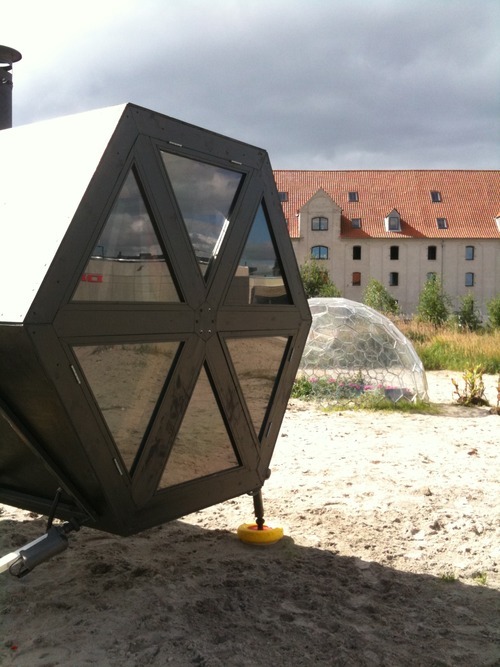
what you see outside the nordic food lab's boat. the house seems to move every day or two. no one knows why.
Posted by
vaughn tan
0
comments
![]()
![]()
Labels: copenhagen


